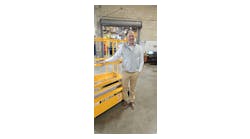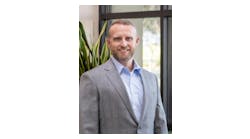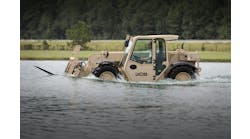Rob Messina, senior vice president of product development and product management, JLG Industries, talks with RER about developing new products by watching lifts on the jobsite and talking with operators; its self-levelling boom lift; integrating robotics with access equipment; and more.
RER: What new equipment enhancements or developments has your company come up with in the past year?
Messina: JLG continues to focus on and invest in delivering equipment and technology solutions that help solve jobsite challenges. In the past year, we have worked to expand our product portfolio and offer modern enhancements to our existing lines. Many of these developments represent a significant change for the aerial equipment market, born from our commitment to understanding our customers’ jobsite challenges and partnering with them to develop solutions that deliver tangible benefits to their businesses. Every day we strive to put this belief into action, and the path to developing the 670SJ boom lift with self-leveling capability is an example of this.
This machine came as a result of our teams watching how boom lifts work on job sites and talking with operators that use this type of equipment every day. Many applications and working environments can be rather challenging for a traditional oscillating axle boom lift to work in because they are only rated to work on firm, level surfaces with five degrees or less of grade. And most job sites aren’t flat — nor will every job site have an improved surface.
To alleviate these challenges, the 670SJ is engineered to automatically adapt to terrain on slopes up to 10 degrees in any direction while driving with full functionality. Essentially, the boom lift’s chassis adjusts to the ground conditions — rather than having to adjust the ground conditions to the machine.
These features have directly led to significant productivity gains throughout the workday. For example, as operators have used our self-leveling boom lifts, they’ve told us that some of the advantages this technology offered them were:
- Fewer chances for dropped tools
- Operators and occupants were steadier during travel due to reduced bouncing of the unit as it traversed uneven terrain for improved operation and reduced fatigue
- Improved productivity translated to more work getting done
- Platform occupants’ fear of heights reduced because of a smoother ride
- Greater stability with operators reported feeling more secure while driving
The term innovation is thrown around so frequently in today’s day and age. However, true, game-changing innovation that improves safety and productivity like our self-leveling boom lift are few and far between. This product represents thinking outside the box to solve actual customer pain points, combined with years of fine-tuning and discovery alongside customers to bring to market a solution that will improve the way people work at height.
Another introduction in our boom lift line was the new Quad Tracks system for JLG 600S and 660SJ models, which offers operators increased machine utilization and flexibility for working on a range of surfaces, including sand, mud, gravel, grass, paved streets with curbs, potholes and sharp transitions.
We also had some notable additions to our scissor lift line-up, including four new rough-terrain and electric rough-terrain (ERT) scissor lifts in 40-foot and 47-foot models. The new RT4769 and ERT4769 represent the tallest machines in their class and provide users with access to five-story heights — an industry first. The new electric-drive JLG ES2646 and the hydraulic-drive R2646 slab scissor lifts have a 20-percent increase in capacity compared to competitive models in the size class, which allows users to carry more materials, like pipes and panels, as well as tools such as welders, to work at height.
And, we can’t forget the big announcement we made in our telehandler portfolio — the addition of the R1370, R1385 and R11100 rotating models. These three machines offer users capacities from 11,000- to 13,000-pounds and maximum reach heights of 67 to 97 feet. The R11100 model is JLG’s highest-reaching telehandler to date.
RER: Any new achievements or developments in safety equipment or accessories?
Messina: As with our product development efforts, JLG has continued to evolve its safety equipment and accessories offerings. One example of this was JLG announcing a developmental partnership with RE2 Robotics in early 2022. This collaboration of our two companies is to advance the integration of robotics with access equipment to deliver improved operator safety and enhanced productivity on job sites.
The initial project the companies are working on together is to produce a remote-controlled aerial lift, with no platform, to install solar panels, which represents the first real step toward autonomous aerial lifts. We’re still in the early stages, although there’s a tremendous interest in maturing this type of technology in the construction space because if we can be successful here, there’s a clear case for a robot in this application.
Obviously longer lead times have been a major concern for rental companies with some saying they are waiting a year or even two years for some machines. What steps are you taking to try to reduce these long lead times?
Messina: Right now, an ongoing challenge we face as a manufacturer is the constrained supply chain, and longer lead times for our customers are a result of this. We are beginning to see signs of stabilization in some categories and anticipate that the whole ecosystem will continue to normalize in the coming year. But right now, demand continues to outweigh supply in many categories, and it is a headwind the entire industry is still working through.
Through this, we’ve learned that we need to become more geographically adaptive and agile. We are working to improve the supply chain resiliency of our products by finding and qualifying additional sources of supply in multiple regions across the globe.
For rental businesses concerned with longer lead times, one thing they can do to help OEMs shorten lead times is to forecast their product needs and secure build slots from manufacturers as soon as possible.
RER: Costs of machines have increased significantly in the recent past? What has led to this cost increase and are you doing anything to try to reduce the cost of new units?
Messina: Insufficient supply, excessive demand, labor shortages, plus escalating raw material and logistics costs, are certainly all factors influencing market dynamics right now. Our focus at JLG continues to be delivering the best possible product to our customers, and to manage these complexities, we are working to improve the forecast of our demand signals and are collaborating with the supply base on these signals.
RER: Have you made any improvements that make machines easier to maintain?
Messina: Our approach to making machines more efficient to maintain is a twofold solution.
First, we continue to incorporate new technologies that evolve and modernize our products, including the ability to service and maintain them. For example, when we introduced the AE1932 DaVinci lift in 2021, it was engineered as the first-of-a-kind all-electric lift — it has zero hydraulics to eliminate the potential for leaks and is powered by a single lithium-ion battery that recharges as the lift descends to lengthen the operational time between charges. These innovations offer our customers machines that require reduced maintenance, adding up to substantial cost-of-ownership savings.
Second, we have also introduced many new tools and accessories that enhance service technicians’ experience with our products. For instance, the Inspection Assistant in JLG’s next-generation Augmented Reality App increases efficiency by providing inspection details and in-depth information on-demand right on the technicians’ mobile devices. The new DaVinciGO app provides intelligent diagnostics through their smartphones or tablets, allowing techs to view, diagnose and troubleshoot the DaVinci lift in real-time, from any location. And, our Handheld Analyzer gives technicians remote access to program, troubleshoot, calibrate or customize JLG equipment performance.
As technology continues to change the way service technicians work, JLG has gone further to offer on-demand access to our library of 3-D hydraulic schematics, available on our Online Express portal. These interactive renderings can help techs troubleshoot hydraulic issues by helping techs locate and trace a circuit to its functions on any JLG boom lift, scissor lift or telehandler model.
RER: Are electric machines and/or alternative fuel machines more in demand these days and what is your company doing to address that need in the marketplace?
Messina: Industrywide, interest in electric products is rapidly increasing due to continued pressure to find more non-fossil fuel-based solutions. We expect to see demand for these types of machines continue to gain popularity as battery technology advances and environmental considerations become more and more stringent.
To address this, JLG continues to work on projects that will add more electrified solutions and model options to our robust portfolio of electrified products.
Are there any other trends you’re expecting to see in MEWPS in the near future?
Messina: Electrification is a major trend that we expect to see grow in the future as urban environments with stringent regulatory requirements target carbon footprints. Not only have we seen urbanization resulting in less open space on and between job sites, which has driven greater demand for high-reach equipment with a compact footprint, but we also see it creating a socio-economic impact. As younger and younger generations enter the system, they demand more social responsibility from an environmental standpoint. As urbanization has increased people’s awareness of environmental issues, there are now more emission-free zones and a call for more fossil fuel independence from a geopolitical standpoint, driving greater demand for electrification.
New tools and solutions are being used to create “moments of autonomy” with aerial equipment, continuing to advance the connected job sites of today and build the smart cities of the future. In some cases, this is happening through practical and digestible features and applications like AR and mobile control apps, and in other instances, we are now seeing the integration of robotics with MEWPs. While these innovations won’t replace humans, they might be used to complete repetitive tasks and particularly hazardous environments where we don’t want to put people.
As we look to the future of MEWPs and the aerial industry, JLG is focused on delivering solutions to what our customers need to grow their business and what they want to solve real-world job site challenges. Our customer-centric approach drives our development efforts ensuring that we are offering products that provide real value. We do this by paying attention to what others are trying, keeping an open mind when we are evaluating opportunities and investing the time and resources needed to bring innovative solutions to the market.






